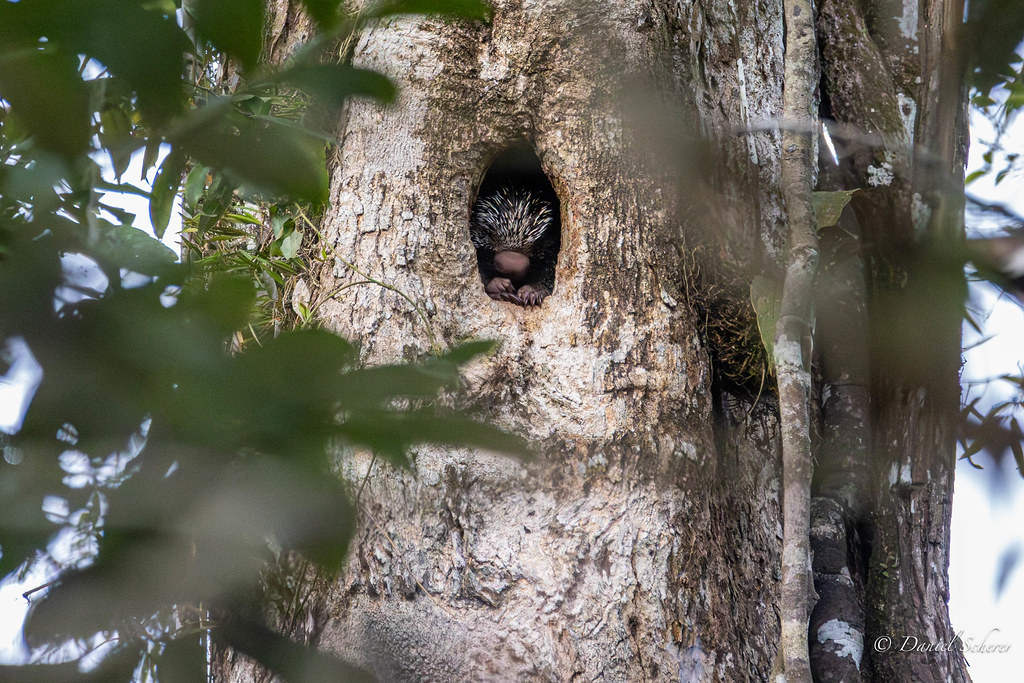The Porcupines that Climb Trees
Friday, 11 April 2025
When you think of porcupines, you might imagine a spiky little creature having a good old waddle across the forest floor, bristling with quills and grumpy charm. But did you know that some porcupines are expert climbers who spend most of their lives in the treetops? Meet the Coendou genus — a group of tree-dwelling porcupines that swing through the forests of Central and South America like prickly little acrobats. Did I mention that they’re cute, too?
 |
| The Paraguaian hairy dwarf porcupine (Coendou spinosus) ranges across Argentina, Brazil, Paraguay, and Uruguay. |
 Coendou, also known as prehensile-tailed porcupines, are
members of the New World porcupine family. They can be found in Central and
South America. Unlike their Old World cousins, which tend to stick to the
ground, Coendous are specially built for life above the forest floor and some
species spend their lives entirely among the branches. They manage this feat with their most
impressive feature - a prehensile tail - strong, flexible, and perfect for
grasping branches. It helps them balance, hang, and climb with surprising
agility.
Coendou, also known as prehensile-tailed porcupines, are
members of the New World porcupine family. They can be found in Central and
South America. Unlike their Old World cousins, which tend to stick to the
ground, Coendous are specially built for life above the forest floor and some
species spend their lives entirely among the branches. They manage this feat with their most
impressive feature - a prehensile tail - strong, flexible, and perfect for
grasping branches. It helps them balance, hang, and climb with surprising
agility.
These porcupines are medium-sized, often about the size of a
house cat, but much chunkier. They have thick fur mixed with sharp quills,
which they use for defence. Despite their cuddly appearance, they're not
animals you’d want to pet - although, to be completely fair, they don’t go
around in gangs looking for trouble either. Coendous are mostly nocturnal and solitary,
preferring to spend their nights quietly munching on leaves, fruit, bark, and
even the occasional flower. Although, they are often spotted snoozing the day away...
One of the oddest things about the Coendou genus is how little
we know about them. New species keep popping up as researchers explore remote
forests. In fact, scientists have described several new species in just the
last couple of decades. As such it is
very difficult to tell how many there are in the wild and which species are at
risk. Deforestation has certainly played
a part in putting these species into potential danger.
 |
| The Paraguaian hairy dwarf porcupine (Coendou spinosus) has a short tail and is covered in grey-brown quills. Its diet includes fruits, vegetables, roots, and even ant pupae. |
In recent years, habitat destruction has threatened many
species in the Coendou genus. As forests are cut down for farming or
development, these tree-loving porcupines lose their homes - and their safety
from predators. That’s why conservation efforts are so important, not just for
the Coendous but for the whole rainforest community they support.
 |
Because they’re shy and live high up in the canopy, Coendous
are tricky to study. But what we do know is that they play a vital role in
their ecosystem. As seed dispersers, they help maintain forest diversity. They
also serve as dinner for some of the jungle’s top predators - although those
quills make for a rather risky snack!
 |
| The black-tailed hairy dwarf porcupine (Coendou melanurus) is a member of the Erethizontidae family. Its range includes Brazil, Colombia, Ecuador, French Guiana, Guyana, Suriname, and Venezuela. |
So next time someone mentions porcupines, surprise them with
this fun fact: some porcupines don’t just walk — they climb, swing, and hang
upside down. The Coendou might not be famous (yet), but in the forests of
Latin America, they’re the stealthy, spiky stars of the treetops.
First Image - Coendou mexicanus




Give a Gift
If you enjoyed this article, please consider making a gift to help Ark In Space to continue to bring you fascinating features, photographs and videos.
Thank you!







